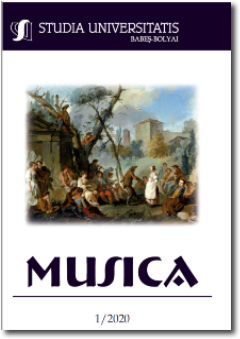COMPARISON OF TWO DIFFERENT WARM-UP TASKS, USING A NEW TOOL ALSO
COMPARISON OF TWO DIFFERENT WARM-UP TASKS, USING A NEW TOOL ALSO
Author(s): Tamás J. Altorjay, Csaba CsíkosSubject(s): Music
Published by: Studia Universitatis Babes-Bolyai
Keywords: vocalisation; SOVT; nose-pipe; voice range; SNR;
Summary/Abstract: In our investigation, we compared two different warming-up sections on the singing voice. In the first section, we used traditional tasks which were based on the “linear model” of the phonation, consisted out of “vocalisation” exercises. In the second section we used developed tasks based on the “nonlinear model” – first and second level - of the phonation, using also the experiences of the SOVT (semi-occluded vocal tract) practice. We applied also a new – personally developed - tool – called “nose pipe”- for the warming-up. The sample consisted of 30 persons, who attend since more than one-year classical singing education, 21 of them were females, 9 of them were males. We organised two different sections. The participants came on both of the sections without previous warming-up for the singing voice. First we recorded three vowels – [i, a, u] – for females on G4, for males on G3 - keeping for longer as 2sec, with comfortable volume, then came the 20’-25’ minute long warming-up procedure. After the procedures we repeated the recordings of the same vowels, and also surveyed the VRP (Voice range profile) of the participants on vowel [a]. For both of the warming-up procedures we used the same melodies. For recording we used TASCAM DR-07 MKII equipment. With the help of a stage, the microphones were held before the mouth of every participant, the same – 10cm – distance. For analysing the records, we used SIGVIEW 2.4., to appreciate the values of the parameters we used the SPSS software. We analysed one-second-long part – well balanced in sound level - of the records. The investigated parameters: number from the noise overriding overtones, the volume of f0 and H1H7, mean of the signal and SNR (signal noise ratio) between 0-9/12 kHz and between 2-4 kHz. During the warm-ups visited voice range and the VRP (Voice Range Profile) surveyed after both of the sections. According to our results both of the warming-up sections are effective. The traditional – vocalisation – has a beneficial effect on volume of f0, on the value of SNR between 0-9/12kHz and on VRP. The second - with nose-pipe - section has beneficial effect on the number of - from the noise enhancing - overtones, on the volume of H1H7, on the voice range visited during the section, and on the values of SNR between 2-4 kHz. As a conclusion we can enhance that both of the sections are useful, but for other aims. The mixed application of them would be referenced. The second section has also an accentuated beneficial effect on “singer-formant” (=intensification of overtones).
Journal: Studia Universitatis Babes-Bolyai - Musica
- Issue Year: 65/2020
- Issue No: 1
- Page Range: 33-44
- Page Count: 12
- Language: English

